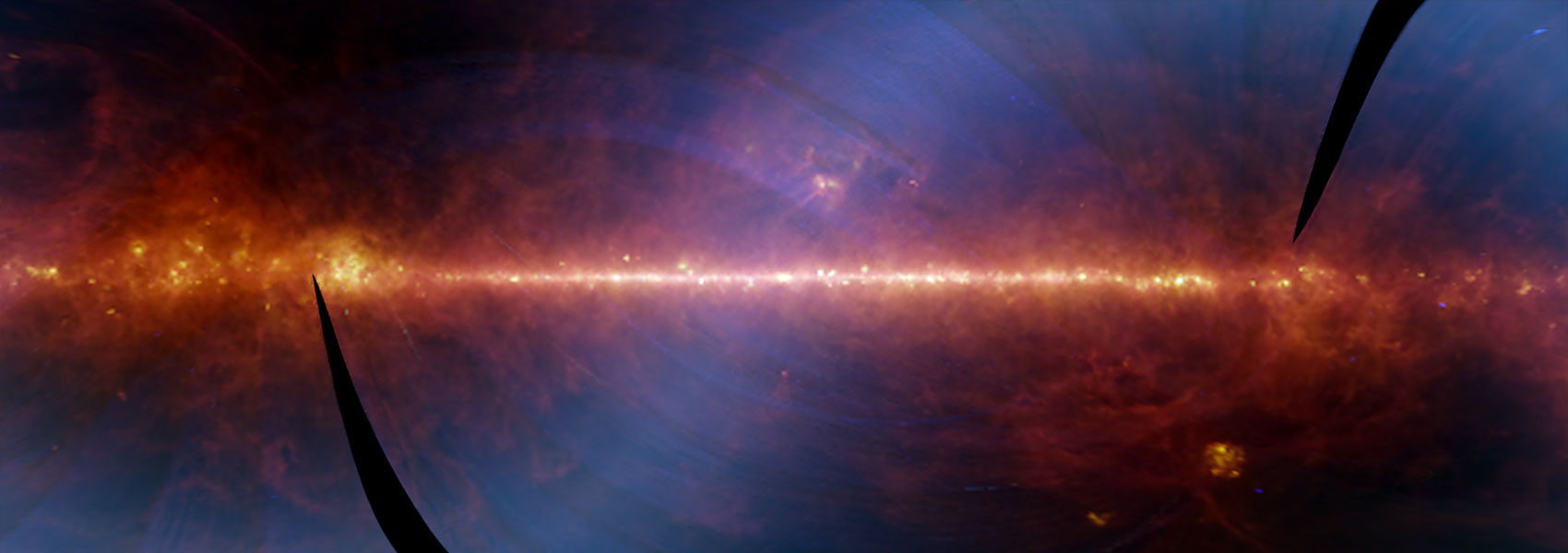
COSMOS-Web Unveils Largest Look Ever Into the Deep Universe

Image above: Example galaxies selected from the COSMOS-Web JWST/NIRCam mosaic spanning 98% of cosmic history.
Andreas Faisst, an Associate Scientist at IPAC, was heavily involved in the initiation of the COSMOS-Web JWST survey and helped finalize and share the data with the astronomical community.
“The data we received from JWST exceeded our expectations. In the COSMOS-Web field, we found the most massive galaxies in the universe and also the most distant galaxy yet confirmed," said Faisst. "What is really exciting is that COSMOS-Web is the largest contiguous area on the sky observed with JWST. This allows us to study the large-scale structure, or the dark matter 'cosmic web' or 'backbone,' of the universe and discover new and statistically rare galaxies. This is not possible with the other JWST surveys, since they target much smaller fields than COSMOS-Web.”
With the unprecedented resolution and wavelength coverage the team achieved in this study with JWST, Faisst was able to analyze the internal structure of galaxies in another paper, recently published.
"For the first time, we could directly observe the impact of ‘lumps’ of star formation, caused by gas instabilities, on the growth of galaxies in the early universe," said Faisst.
The data will soon be available on IRSA, the NASA/IPAC Infrared Science Archive.
COSMOS-Web provides the largest view deep into the universe ever, and now all of its data are available publicly in an easily searchable format.
COSMOS-Web was the largest General Observer program selected for Cycle 1 of the James Webb Space Telescope (JWST). The survey mapped 0.54 square degrees of the sky (about the area of three full moons) with the Near Infrared Camera (NIRCam) and a 0.2 square degree area with the Mid Infrared Instrument (MIRI).

The COSMOS-Web JWST field is part of the COSMOS field, which has been observed originally by the Hubble Space Telescope in 2004.
“The sensitivity of JWST lets us see much fainter and more distant galaxies than ever before, so we’re able to find galaxies in the very early universe and study their properties in detail,” said Jeyhan Kartaltepe, associate professor at Rochester Institute of Technology, who co-leads COSMOS-Web with University of California, Santa Barbara physics professor Caitlin Casey. “The quality of the data still blows us away. It is so much better than expected.”
“Our goal was to construct this deep field of space on a physical scale that far exceeded anything that had been done before,” said Casey. The survey has captured some of the rarest objects in the universe, and now these images and supporting data are available for scientists to delve in and make further discoveries.
The deep imaging comes with a catalog (the “COSMOS2025” catalog), which contains photometry, structural measurements, redshifts, and physical parameters for nearly 800,000 galaxies. Thanks to JWST imaging and previous COSMOS data, the catalog opens many unexplored scientific avenues.

Zoom in on the COSMOS-Web JWST survey field showing far-away galaxies of various structures and colors – to study these is the goal of the COSMOS-Web survey.
“This was an ambitious undertaking that required the development of innovative technologies to simultaneously measure the photometry and morphology of nearly 800,000 galaxies across 37 images,” said Marko Shuntov, postdoctoral researcher at Cosmic DAWN Center and lead author of the paper describing the catalog. “Building the catalog required tremendous teamwork, and it was all worth it because ultimately it has delivered some of the highest quality redshifts and physical parameters of galaxies that will enable groundbreaking science.”
“A big part of this project is the democratization of science and making tools and data from the best telescopes accessible to the broader community,” said Casey. The data were made public almost immediately after they were gathered, but only those with specialized technical knowledge and supercomputer access are able to process them into a form useful for scientific analyses. The public availability of the catalog takes that work out of the equation for the community and hence will produce groundbreaking science beyond the initial science goals of the program. The COSMOS-Web team worked diligently to reduce the data, eliminating artifacts, subtracting backgrounds, and improving the astrometry in order to provide accurate photometric and morphological analyses.

An image of a small part of the COSMOS-Web field taken by the Spitzer Space Telescope (left) and the JWST (right) as part of the COSMOS-Web survey. This shows the improvement in image sensitivity and spatial resolution of the JWST.
The breakthroughs already discovered through JWST’s observations have shown how essential NIRCam data is for understanding galaxies in the early universe. Ensuring that the data are science-ready is an achievement that makes COSMOS-Web the standard calibration for future, large surveys and the next generation of telescopes.
“We combined more than 10,000 images of the sky together to form the largest contiguous image available from JWST,” explained Maximilien Franco, postdoctoral researcher at the Université Paris-Saclay and lead author of the work presenting the COSMOS-Web NIRCam data.. “To do this, we needed to ensure that all the images were properly aligned with existing data, and also to correct for any observational biases. It was incredible to reveal galaxies that were previously invisible at other wavelengths, and very gratifying to finally see them appear on our computers.”

COSMOS-Web NIRCam mosaic (upper left) with zoom-ins to the region surrounding the COSMOS-Web Ring (upper right).
Likewise, MIRI plays a critical role in identifying and determining the mass of early galaxies and investigating star formation over cosmic time. It has already been instrumental in confirming some of the most distant galaxies discovered by JWST. Using longer wavelengths that are less affected by dust extinction, MIRI has the ability to detect and characterize galaxies at higher redshifts, or at earlier times in the universe.
“It’s remarkable to see how much progress we’ve made since Spitzer’s pioneering work in the mid-infrared,” said Santosh Harish, postdoctoral research associate at Rochester Institute of Technology and lead author of the work presenting the COSMOS-Web MIRI data.. “With MIRI, we’re now accessing an unprecedented level of detail in this wavelength range, providing new insights into the processes driving galaxy evolution and the growth of black holes. The leap in sensitivity and spatial resolution is extraordinary, and MIRI observations from COSMOS-Web are a fine example of what this instrument is capable of.”

MIRI layout of the COSMOS field with a few example galaxies highlighted, showing a comparison between JWST/MIRI and Spitzer/IRAC at the same wavelength.
Along with the data itself and three initial papers on the catalog, near infrared imaging, and mid infrared imaging, the data release also includes an interactive viewer where users can directly search images for specific objects or click on objects to see their properties.
When JWST launched in 2021, the COSMOS-Web team of nearly 50 researchers around the world had the longest observing time during the telescope’s first year. The team set out with three primary goals: to map and build understanding of the Reionization Era (the universe’s first billion years after the Big Bang); to trace and identify massive galaxy evolution in the first two billion years; and to study how dark matter is linked to visible matter within galaxies.
After more than 150 visits and 250 hours of observations, the JWST data from COSMOS-Web has provided the information to obtain those goals. The survey has sent scientists into a new age of space observation and data analysis, and has opened the door to a future of understanding and discovery like never before.
“We have data and catalogs that we’re very sure of, that we’ve tested and put a lot of work into,” added Kartaltepe. “I can’t overstate how much the field has changed. With data from JWST, we now have a new window into the universe.”
In addition, two new COSMOS-Web studies – one examining the structural evolution of brightest group galaxies over the past 11 billion years, and another applying artificial intelligence to estimate key galaxy properties from photometry – highlight the wide scientific potential of the catalog.
“Thanks to JWST and the COSMOS-Web survey, we can now trace how galaxies shut down star formation, undergo morphological transformation, and how these processes are shaped by their environment across cosmic time, even predicting galaxy properties using AI-driven methods,” said Ghassem Gozaliasl, astrophysicist and researcher at Aalto University.
In today’s climate, open, accessible science is more important than ever. Anyone in the world can now access the same catalogs and images used by the COSMOS collaboration. At the same time, the remarkable longevity of the collaboration is a natural consequence of the open nature of the team; anyone may join and contribute to the excellent science being done with COSMOS data. This collective spirit has been remarkably successful in continuously reinvigorating the team over the past twenty years.
Processing the COSMOS-Web data, from pixels to catalogues, was carried out on a dedicated computer cluster at the Institut d’Astrophysique de Paris, funded by the Île-de-France region, the French Space Agency (CNES), and the French National Centre for Scientific Research (CNRS).
COSMOS-Web is jointly led by Kartaltepe and Casey as part of The Cosmic Evolution Survey (COSMOS). Beginning in 2007, COSMOS joined together more than 200 scientists across the globe to study the formation and evolution of galaxies using both space-based and ground-based telescopes.
For more information on COSMOS-Web, go to the program’s website. The COSMOS-Web images, catalog, and interactive viewer are available through the team’s data release website. See the coordinated press release at several institutes, including RIT, UC Santa Barbara, IAP, LAM, DAWN, UT Austin, Caltech/IPAC, IAC, Aalto University, and Northeastern.
- Date: June 18th, 2025
- Category: Project News
- View Image



